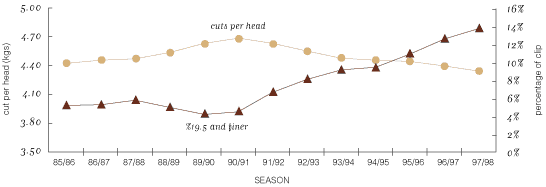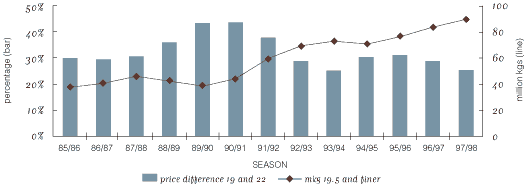Lionel Ward. Wool CRC Director
There was a certain amount of scepticism among Wool CRC researchers, when the graph below (figure 1) was produced for internal planning purposes.
USING A THREE YEAR MOVING moving average to minimise season-to-season effects, it shows that average fleece weights declined steadily through the 1990s by nearly 0.4 kilograms per head, having risen quite rapidly through the second half of the 1980s. Conversely, the proportion of fine wool produced (19.5 micron and finer), rose sharply (from 5% to 14%) having contracted slightly in the late eighties.
The inference is clear and hardly new. That is, production of finer wool means a sacrifice of fleece weight. That reality from the past has been the major force behind one of the Wool CRC’s research programs; namely, development of a breeding program that enables producers to lower fibre diameter and raise fleece weights in their flock.
Some Wool CRC colleagues thought, however, with good reason, that the effect may have been overstated due to the impact of seasonal conditions and flock structure. Our attempt to examine this more thoroughly was thwarted a little by discontinuity of the data but we were able to make some observations from the data available:
- A series of ‘good seasons’ in the late 1980s would have contributed to higher fleece weights and increased fibre diameter in that period. Conversely, the ‘poor seasons’ in the 1990s would have caused the reverse effect. However, the pasture growth index (used in production forecasting by the Bureau of Agriculture and Resource Economics) shows that the overall trends established by the graph were not materially affected by seasonal conditions.
- Contrary to expectations, the proportion of ‘ewes for mating’ in the national flock was higher in the 1980s than the 1990s (breeding ewes normally have a lower fleece weight).
- That observation was borne out by the proportion of lambs and hoggets (lower fleece weights) in the flock being slightly higher in the late 1980s than the first half of the 1990s.
- Average staple length of wool sold at auction also declined from the late 1980s, particularly at traditional ‘fine wool’ selling centres (Goulburn, Newcastle and Launceston), a trend that is also associated with increased fine wool production.

Figure 1
Three year moving average of cuts per head and quantity of 19.5 micron and finer
expressed as a percentage of total clip for period ’85/86 to ’97/98.
On balance, therefore, much of the falling average fleece weights in the 1990s can be attributed to the rising proportion of fine wool production – a result of substituting typical medium wool strains with conventional fine wool strains. It means that, although the value of the clip has benefited significantly from the big increase in fine wool production, the gross gain has been eroded by more than $180 million due to lower fleece weights.
That sort of estimate places a high priority on achieving success in the adoption of the Wool CRC’s genetic technologies. CSIRO Animal Production and NSW Agriculture have combined to show how producers can successfully breed sheep from within their own flocks to reduce fibre diameter AND raise average fleece weights. Now they are working through their respective service arms (Select Breeding Services and Advance Breeding Services) to encourage all growers to adopt the new breeding practices.
Importantly, the NSW Agriculture trials have shown that medium micron producers have available bloodlines that will lead to declining fibre diameter with similar/better fleece weights.
Account needs also to be taken, however, of potential negative price effects caused by the increased supply of finer wool. Figure 2 looks at the quantity of wool 19.5 micron and finer over recent years, and shows that the steady increase has not significantly eroded the premium of 19 micron wool over 22 micron (aside from the distorted markets of 1989-92).

Figure 2
Three year moving average of price differentials between
19 and 22 micron categories expressed as a percentage and quantity
of 19.5 micron and finer expressed in mkg for period ’85/86 to ’97/98
It is true that the margins for fine wool in 1998-99 will be down (due to the depressed market), but that does not represent a long-term situation. Trends in consumer demand will continue to favour lighter weight fabrics and that should be reflected in a return of historic premiums for fine wool categories.
Although the focus here has been on wool 19.5 micron and finer (where premiums are greatest), the principle of moving finer plus gaining fleece weight, applies generally to all apparel wool in all growing conditions. The technology transfer challenge we face is truly national in its dimensions.
In this issue of The Wool Press: